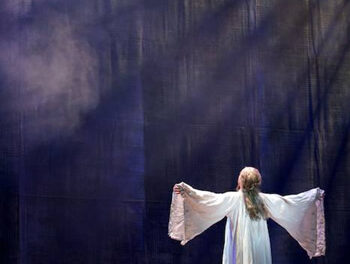It was a beautiful, cool spring evening, and there was a festival-type atmosphere on the patio outside the Carolina Theater in downtown Durham. There were activities for children and booths celebrating the burgeoning Latino heritage in Durham. It was May 4, the eve of Cinco de Mayo, the most celebrated Mexican holiday. Performing at the theater was Sones de México, a remarkable group of musicians based in Chicago. It seemed like everything had come together for an amazing event. So, where was everybody? When the show began, the theater was probably one third filled – and that’s a generous estimate. For a community with such a large and growing Mexican population you would have thought there would be a sold-out show. For those who were there, it was like a great party, and a memorable night it was!
Sones de México, formed in 1994, takes its name from the Spanish word son, used to define a large family of regional music and dance styles. Each region or state has its own son, and Sones de México took us on a tour of many of these, each with its own repertoire, instruments, and styles of dancing, singing, and dress. To accommodate these differences, an enormous range of instruments are played. Noticeably missing from this group, despite the stereotypical caricature of mariachi bands, are trumpets. Actually, the only iconic Mexican instrument on stage was the guitarron, an oversized six-string bass guitar, played for most of the evening by Juan Díes, the spokesman for the group, who gave informative introductions to each work played, in both English and Spanish. Victor Pichardo, director of the ensemble, plays violin, clarinet, guitar, and huapanguera brilliantly. Renato Cerón plays an amazing assortment of wind instruments plus violin, accordion, and a Peruvian-style harp that added wonderful color to the mix. Joel Martinez, the percussionist, came out front in one number to play a bare wooden resonating box with such force that you wondered why all of the bones in his hand were not broken. Nothing against these fine gentleman and exemplary musicians, but it was nice to have Lorena Iniguez in the group as the dancer and sometimes drummer and guitarist. Several times during the evening she appeared in an elaborate, colorful costume and danced. These were relatively simple folk dances but it was a wonderful visual treat.
This was an informal and friendly evening. There was banter between audience members and Díes, and many of the people cheered loudly when names of certain Mexican regions or states were mentioned. This was definitely an upbeat celebration that recreated the atmosphere of a traditional fandango, or dance fiesta. There must be some ballads, laments, or slow tunes in the culture, but on this evening it was all joyous, colorful, and – well – party music. You can imagine how it must be to hear such an incredible band outside, with everyone dancing, drinks flowing, and hormones raging. In fact, during one number, Iniguez came out into the audience, grabbed a guy, and danced with him, and soon there were a dozen or more couples dancing on top of the orchestra pit in front of the stage. Ironically, the music they were playing was a polka, and it would have been just as appropriate at a German wedding as a Mexican fiesta.
The vocal style is quite pleasant although quite predicable. All the men have high voices, and they always sang in thirds, in the same rhythm. I am not very familiar with this style of music, so admittedly it could be a case of musical cultural bias that after a while much of what I heard began to sound similar. That is not to say that I did not admire the virtuosity and versatility of the musicians. Probably someone who has not listened to many string quartets would come away from a concert of Haydn, Bartók, and Philip Glass saying it all sounded the same, too. One particularly interesting selection involved some Buck Owens songs given with a Mexican spin – the one time the ensemble sang in English.
This was a great opportunity to experience and learn about a musical style that for the most part stays within the Mexican community. Here’s hoping some other presenters will take a chance on this wonderful group or similar ensembles and help spread the words, music, and dance!











